Column: Orpheum Bell, Handmade Music
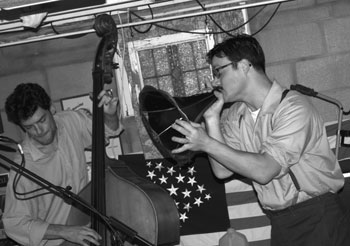
An Orpheum Bell rehearsal: On bass, Serge van der Voo; vocals sung through a gramophone horn, Aaron Klein.
I’m wedged in the corner of a west side Ann Arbor basement amongst a jumble of musical instrument cases. The cases belong to the six musicians of Orpheum Bell. There’s more than one case per musician – they each play an array of different instruments. During a break in the rehearsal, I have to ask: What is that? It’s a Stroh violin, “spelled like the beer,” explains Annie Crawford.
The rehearsal is geared towards a CD release show at The Ark on Dec. 4. I’m soaking in the sounds of the basement practice mostly because of that CD, the group’s second – “Pearls.”
Serge van der Voo had sent along a review copy of the CD to The Chronicle. In a world of MP3 files flung around the Internet, a physical CD is an awfully clunky way to deliver musical data. But when I unfolded the heavy card stock CD cover into its 16-inch total length, I noticed one of the folds was not exactly uniform and regular – not the way you’d expect if a machine had produced several thousand of them.
An even closer examination revealed that the print quality was not the laser-like rigid perfection that a modern digital printer delivers. Which is not to say it was sloppy. On the contrary. It was more like trace-evidence that human hands had played a role. Who were these people with the apparently handcrafted CD case? To get some insight, I had crammed myself back amongst those instrument cases in the corner of a basement for two hours.
The CD cover was imprinted with artwork and text by a hand-fed cylinder letterpress. And now it’s imprinted with my musical memory of that two hours of rehearsal. It’s upon that physical artifact that I will hang the pleasant recollection of an evening spent listening to live music played by some extraordinarily talented musicians.
Orpheum Bell: Music and Words
The music of Orpheum Bell is self-described as “country and eastern.” The country elements are easy enough to pick out: banjo, bass, mandolin, violin.
But Laurel Premo’s style is not the ostentatious metallic ringing banjo typical of some American country music. Instead, it is an almost muted strum that can still tickle forth individual notes from her open back 5-string. And Annie Crawford’s Stroh violin, with its metal horn, projects a sound a bit different from a country music fiddle.
The eastern influences come partly from the Stroh violins, but more from Michael Billmire’s accordion. And based on their sound, it’s on occasion easy enough to imagine that Orpheum Bell is a band of gypsies. The tracks that feature Merrill Hodnefield’s musical saw are just a little bit spooky.
Part of what makes it difficult to slot Orpheum Bell into a convenient musical slot is their use of variation in tempo – all driven by van der Voo’s bass, whether he’s bowing it, plucking it, or whacking its body with the palms of his hands.
During rehearsal, at the conclusion of one tune – which included lyrics about the Cayahoga River – Premo remarked that it was “rubato-ish.” It seemed to pull them along, she said.
What Orpheum Bell has achieved musically with this new CD “Pearls” is consistent with the poetry of Aaron Klein, who’s responsible for most of the lyrics and much of the music. It’s not surprising that songs collected together under the title “Pearls” have water imagery woven throughout.
Take the first track on the CD,”What If No Sparrow Fell,” which includes a line that I would like to imagine was inspired by standing at Argo Dam and looking first south, and then north along the Huron River: “The river’s skinny but the pond’s so wide …” It’s hard not to point out that the Huron connects Orpheum Bell at least indirectly to Ann Arbor’s recent history – van der Voo’s wife, Kirsten Elling, is the daughter of Liz Elling, who swam the length of the river in the summer of 2007.
In “Sparrow,” water also can be found in the tears that flowers “wept by the bandshell as the rain swang wide.”
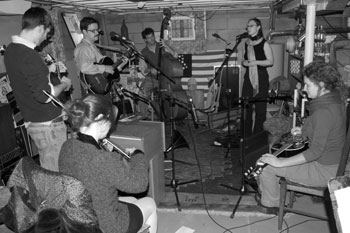
Starting with the bass at 12 o'clock and going clockwise: Serge van der Voo, Merrill Hodnefield, Laurel Premo, Annie Crawford, Michael Billmire, Aaron Klein. (Photo by the writer.)
And I would again like to imagine a specific local Ann Arbor connection that might have inspired the lyric – the Westpark Bandshell, not so awfully far from the west side basement where Orpheum Bell rehearses. (I was raised on a literary tradition that doesn’t place much stock in author intent or inspiration – Klein’s text is mine now, to hear how I like. You can ask him if you want, but I’m not going to.)
Between the first and the last tracks, fountains, lakes, oceans and harbors populate the landscapes that Klein describes.
And on the last track of the CD, “Don’t Let On,” it’s one of the CD’s numerous flowers that ties into the watery thematic flow: “The rose whispers from the deep well/ Don’t need more water, but I could use some more light.”
But it’s not all flowers on this CD: “Every garden needs a weed” is the wisdom offered by “New Hearse for Hastings.” And it’s that idea, I think, that captures the aesthetic of Klein’s gravelly voice – accentuated in its gravelly glory when he sings through a gramophone horn – contrasted with the pretty vocals of Orpheum Bell’s female singers.
It’s a reminder that actual people, not robots, provide the manual musical labor that makes for the pleasant sounds we’re hearing.
Printing the CD Cover: A Collaboration
Manual labor also produced the CD cover that van der Voo had sent to The Chronicle – labor shared across several shoulders. He and his wife, Kirsten Elling, used an old 1950s-era hand-fed cylinder letterpress to print the designs, using copper plates that Geoff Innis had prepared.
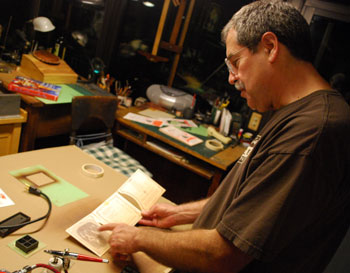
Jim Horton whose hand-fed cylinder letterpress was used to print the CD covers, gets his first look at the results. (Photo by the writer.)
Innis, who works for Perich Advertising + Design, had the plates made by Owosso Graphics, located in a Owosso, Michigan.
The calligraphy on the old bank check design that forms the back of the CD cover was rendered by Kelly Burke – someone Aaron Klein had randomly met at a local art supply store.
The check itself was designed with help from Bob Hohertz of the American Society of Check Collectors.
The letterpress used for the printing sits in the basement of Jim Horton, along with several other old presses and type-setting gear. Horton teaches studio art and printmaking at Greenhills School and Hollander’s School of Book Arts.
Van der Voo indulged a request from me to see the press. And that meant he drove me out to meet Horton where he lives near Waters and Wagner roads, amongst a woods that boasts some pawpaw trees.
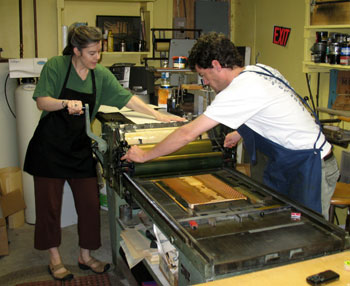
Kirsten Elling and husband Serge van der Voo operated the press during printing of the CD cover. (Photo by Geoff Innis.)
When van der Voo handed him a copy of the CD, Horton was getting his first peek at the finished CD cover. He was clearly satisfied with the output from his press.
He discerned a spot with slightly non-uniform ink distribution – and was delighted. It seemed to be exactly the desired effect.
Horton explained that the 1,000 or so copies of the CD cover that Orpheum Bell had printed were pushing the limits of what the press was designed to do, which was to make proofs of newspaper pages before a proper press run.
Recording the CD: An Ethic of Realism
Orpheum Bell’s CD was recorded, mixed and mastered by Jim Roll at his Ann Arbor studio, Backseat Productions. I phoned him up to ask about the “Pearls” recording, and any special challenges posed by Orpheum Bell’s commitment to less-than-modern instruments – Stroh violins, gramophone horns and the like.
Roll talked about the philosophy of his approach to recording: “The ethic of the studio is realism as opposed to modern production,” he explained, “so, they [Orpheum Bell] were a good match.”
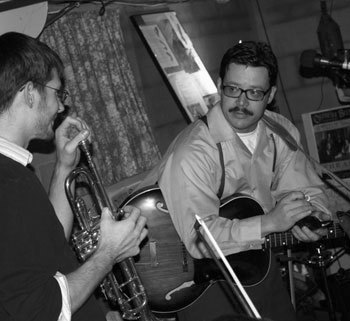
Michael Billmire (trumpet) and Aaron Klein (guitar) take a break during the Orpheum Bell rehearsal. (Photo by the writer.)
Achieving that realism entails backing the musicians off the microphones a little bit, Roll explained, “to make sure you can hear the room.” The idea, he says, is to leave “the grit and the reality” there on the recording.
Roll had mixed, but not recorded, Orpheum Bell’s first CD, “Pretty As You,” which was done live with no isolation of individual tracks. For “Pearls,” Roll explained, the bones of each song – bass, guitar and vocals – were recorded live, with other instruments like violins and accordions added later. But they never record to a click track (a metronome), Roll says, to make sure that variations in tempo can come across.
Towards the end of the basement rehearsal, Orpheum Bell goes through the track from “Pretty As You” that bears the same title as the whole CD – it’s planned as their final number at the CD release show at The Ark on Dec. 4. And the discussion at the rehearsal focuses on the question of tempo – do they want to finish it that way? Van der Voo concludes: “I’m happy to end on that pace.”




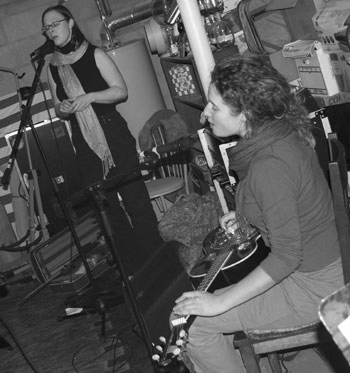
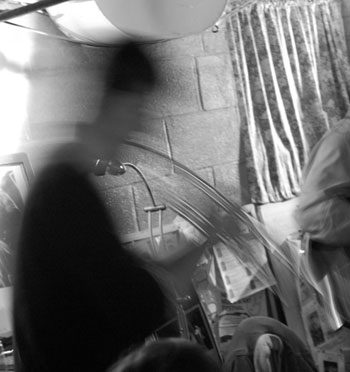
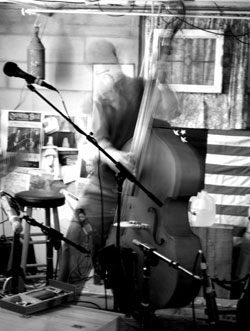
This is a fantastic article! I am an intern for Mr. Jim Roll and I was there during the recording of ‘Don’t Let On’ and ‘New Hearse For Hastings.’ Orpheum Bell are truly talented musicians and they are all exceptional people. It was a fantastic experience and in reading your account I know that they are always on top of their game. Please continue to write such honest, complimentary articles, it is a breath of fresh air in this anxious tense world!
It is such a difficult thing — to describe music with words. I can only say that all things change and this is a very special time in the life of the most emotionally moving group I have experienced. Catch a performance while you can. Orpheum Bell – I fell in love with them – I just couldn’t help it.